Efficiency of β-glucan utilisation in fish culture
Abstract In the last three decades aquaculture is a rapidly developing sector worldwide and antibiotics are used popularly as growth promoter. Antibiotic use was banned because research proved that antibiotic has caused many effects on environment and human health. Therefore, finding antibiotic alternatives is the first priority. The most prospect products today are probiotic and prebiotic. β-Glucan is one of the immunostimulants which showed a variety of benefits to the health of many aquaculture species. In this paper only the results of β-glucan, a kind of prebiotic supplied in aquaculture, were summarized. The major benefit of β-glucan are to boost growth, to reduce mortality, to enhance tolerance or stress resistance to environmental or pathogen challenges. Although the applications of β-glucan are popular worldwide, its use in aquaculture in Vietnam is still limited. This paper provides an important reference for β-glucan utilisation which may help to develop a sustainable aquaculture in Vietnam
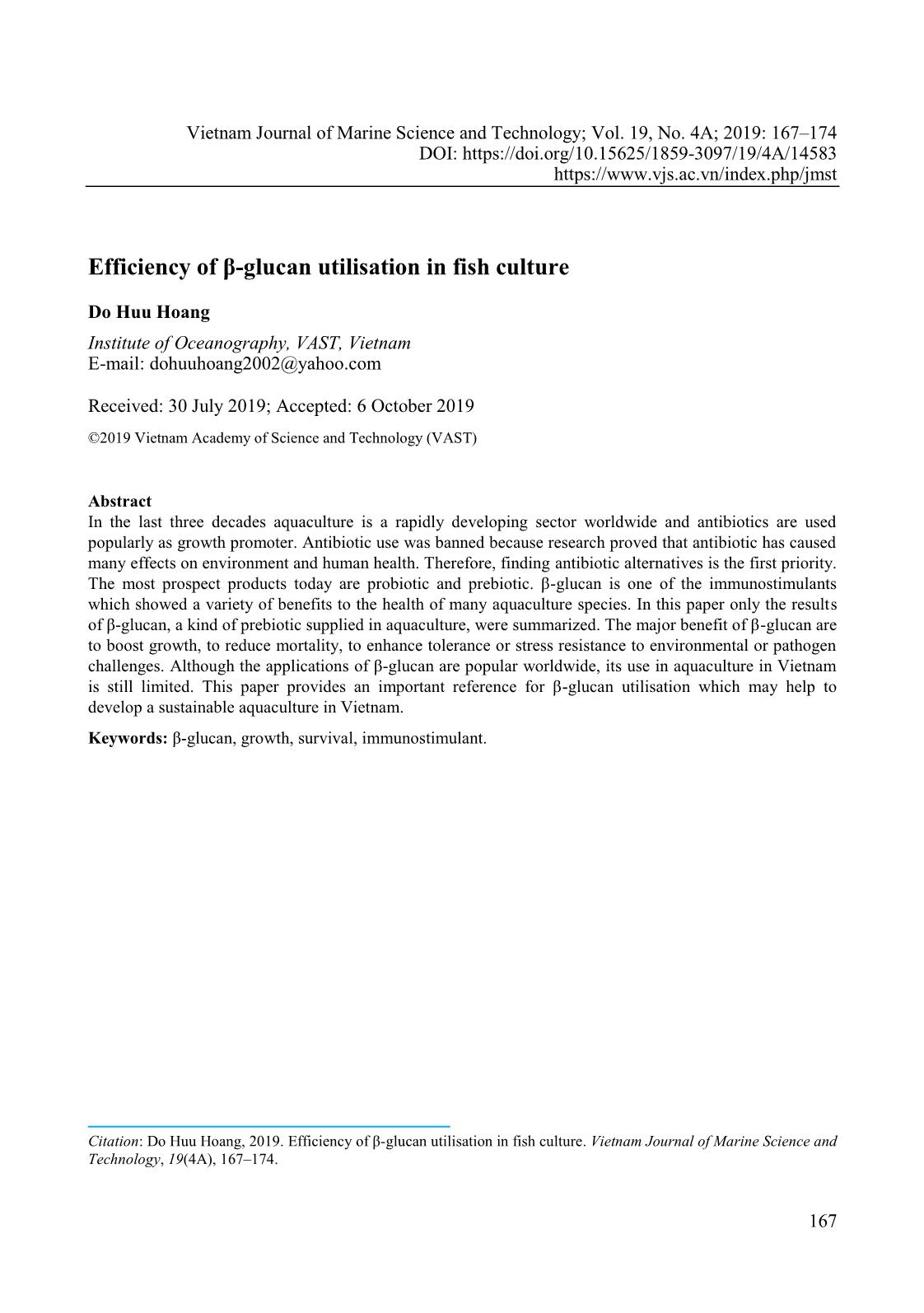
Trang 1
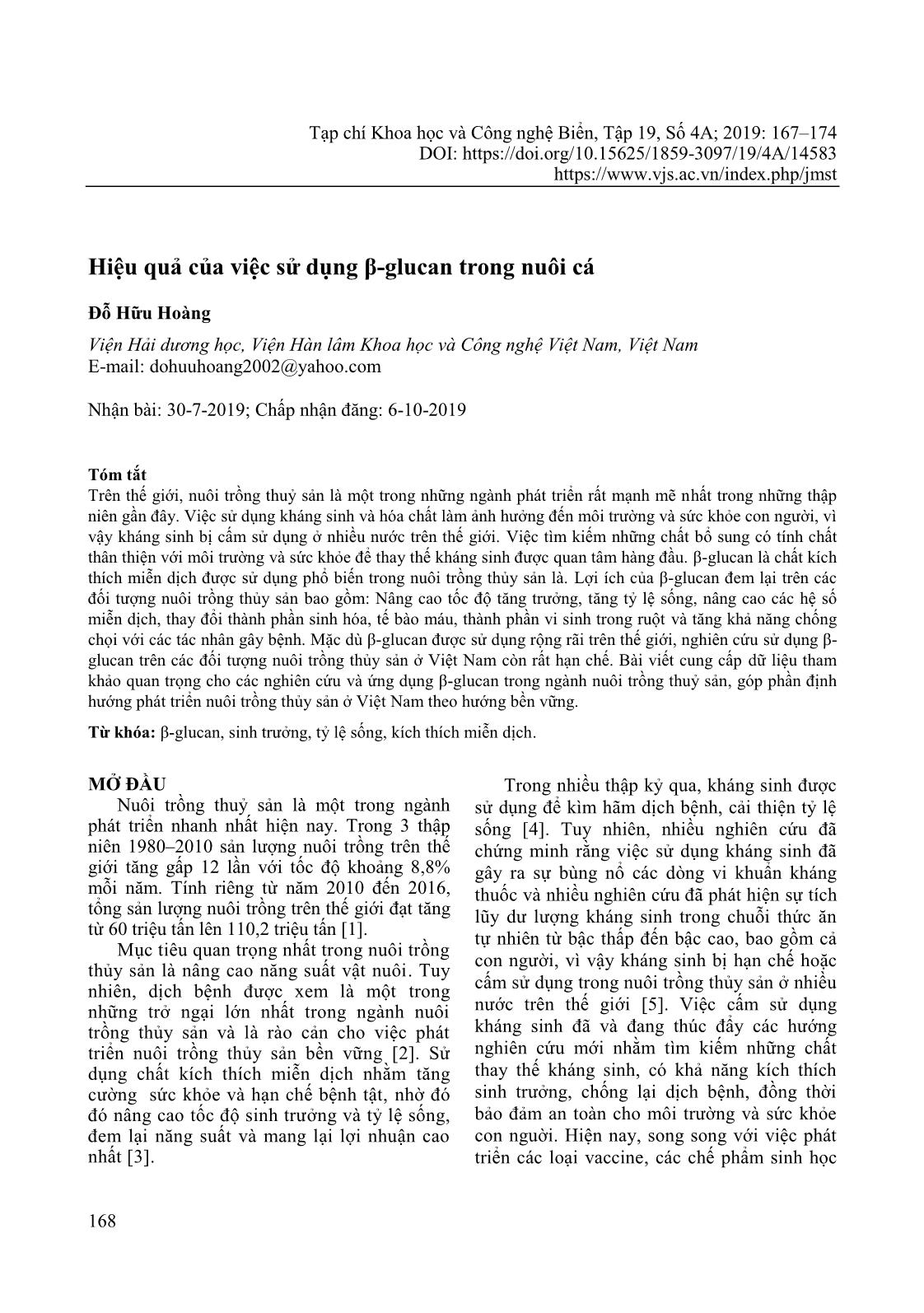
Trang 2
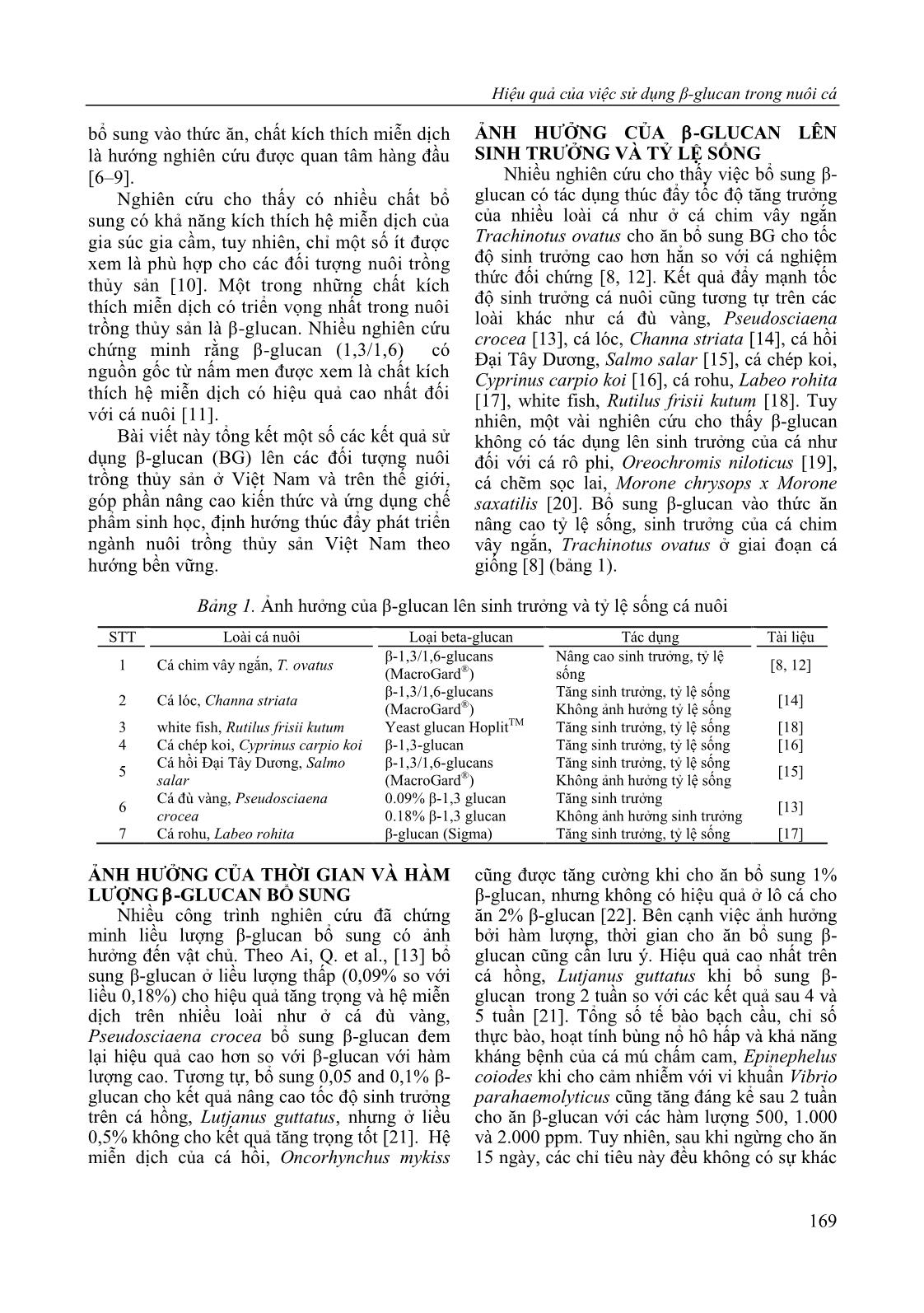
Trang 3
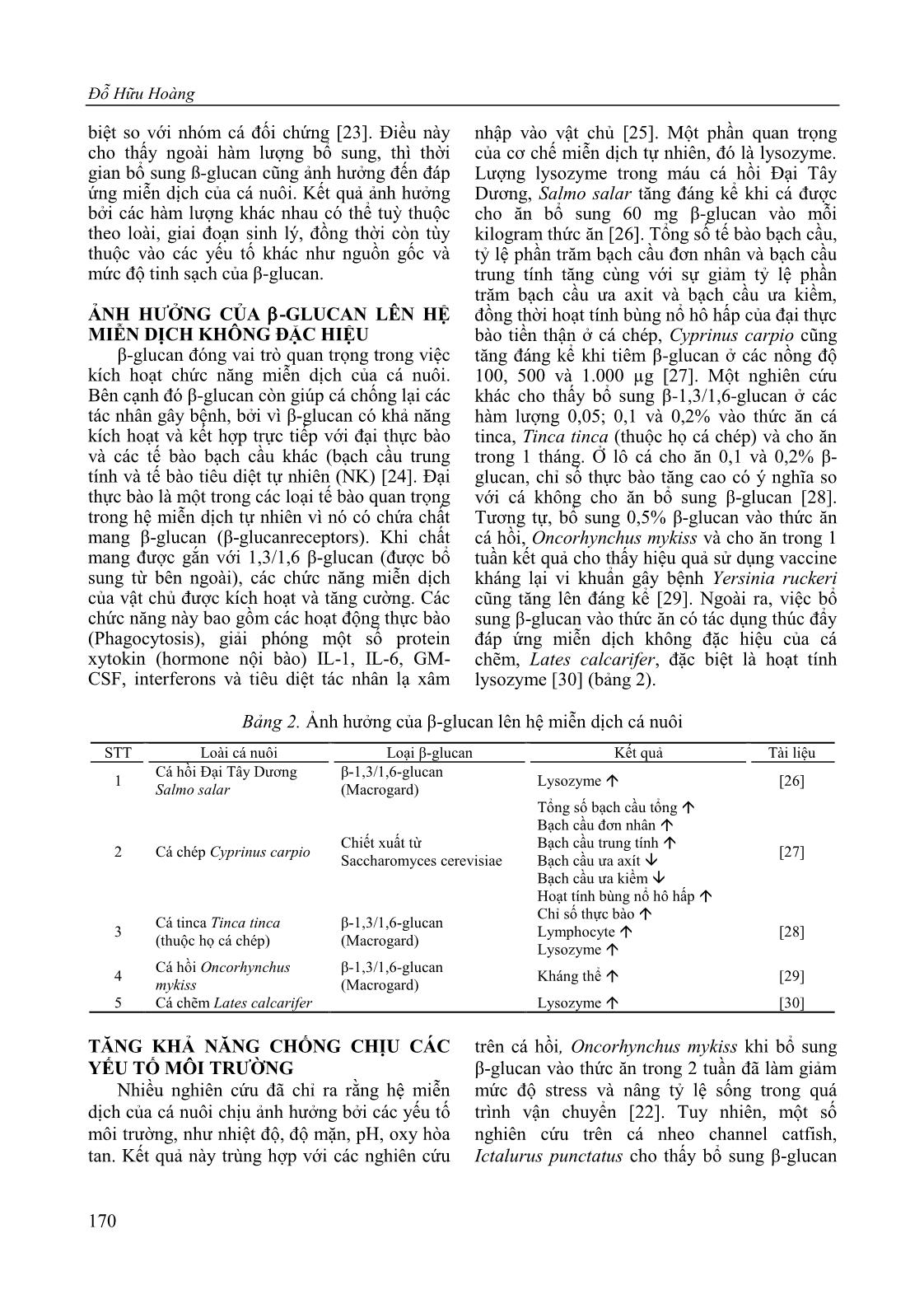
Trang 4
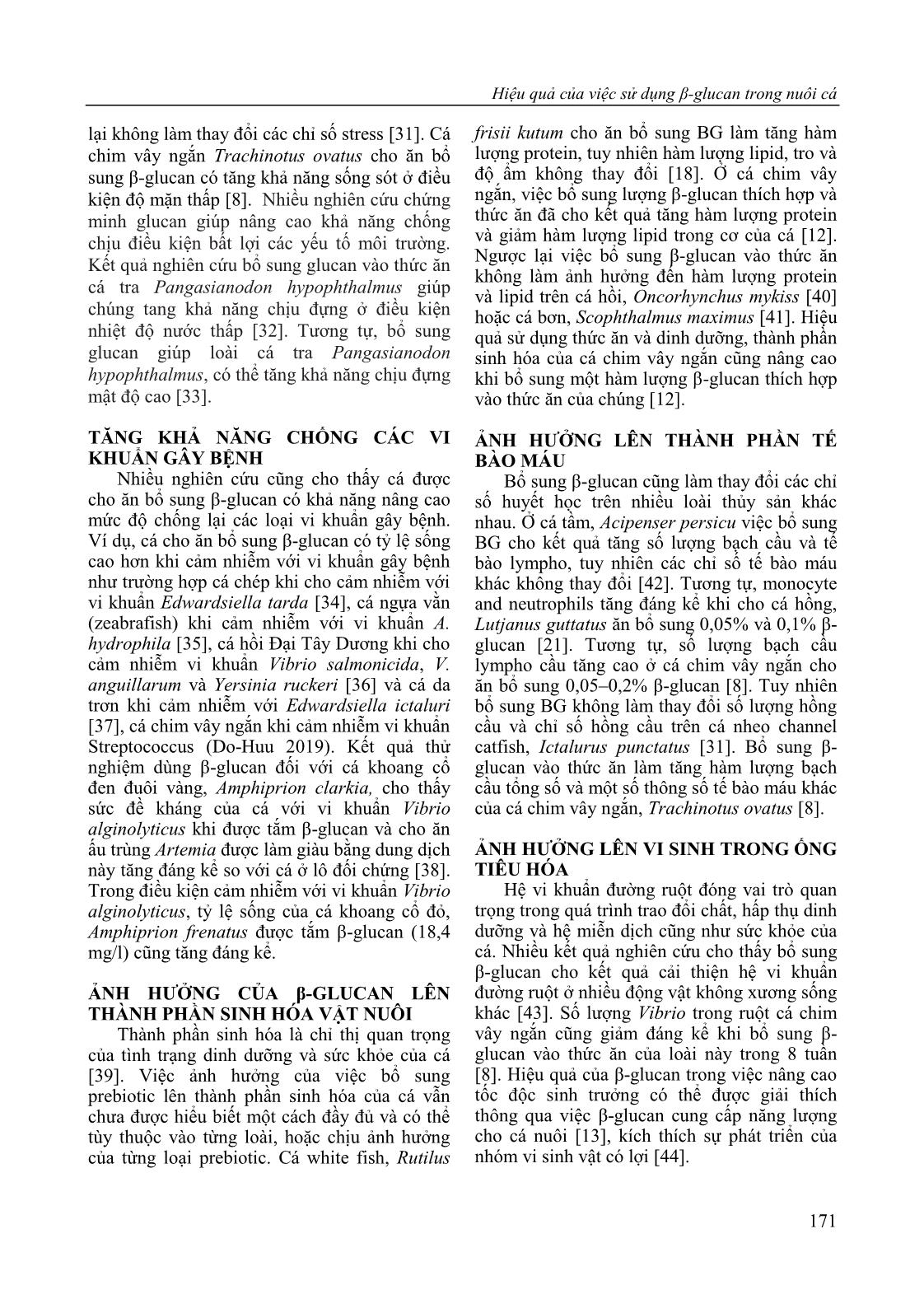
Trang 5
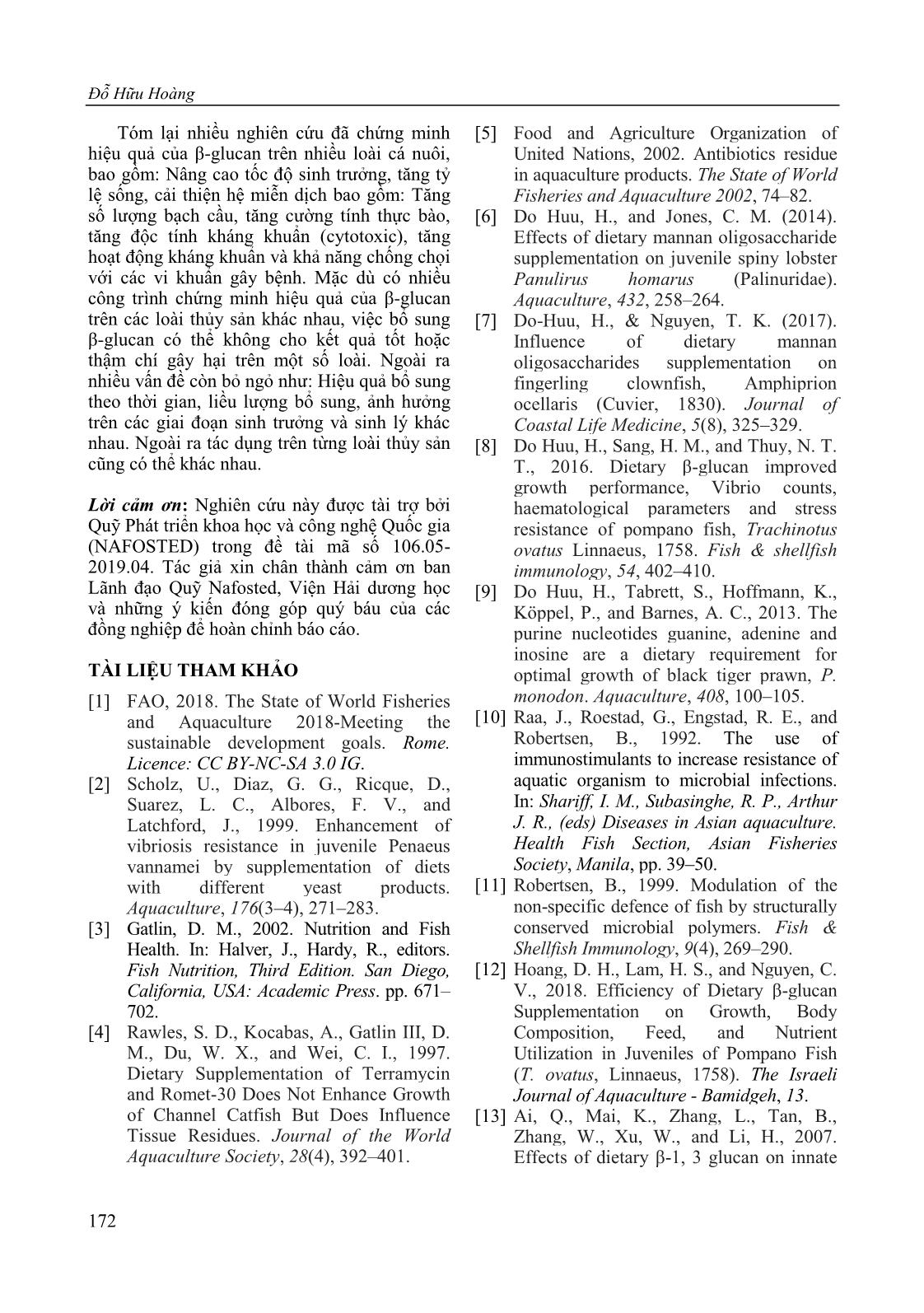
Trang 6
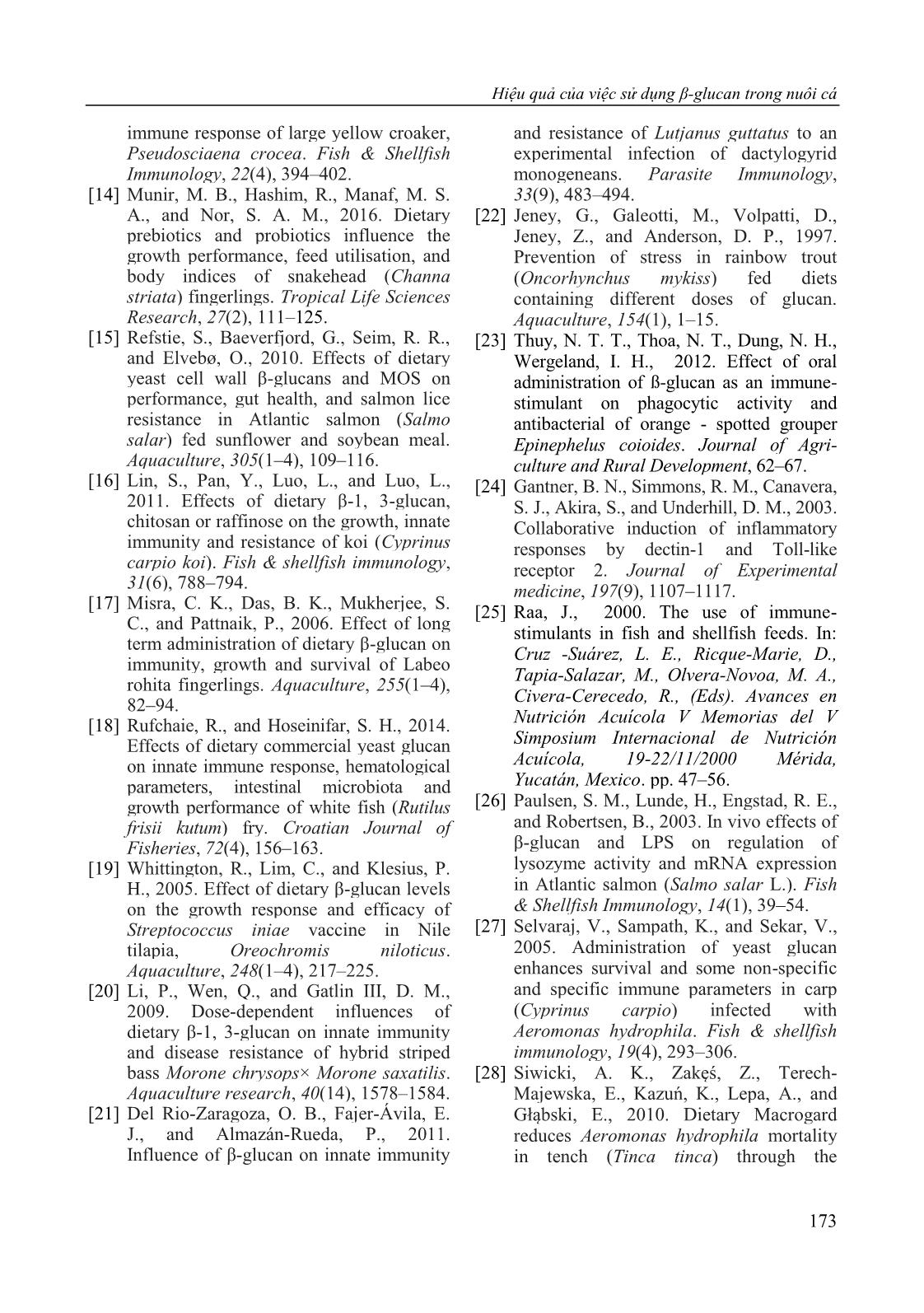
Trang 7
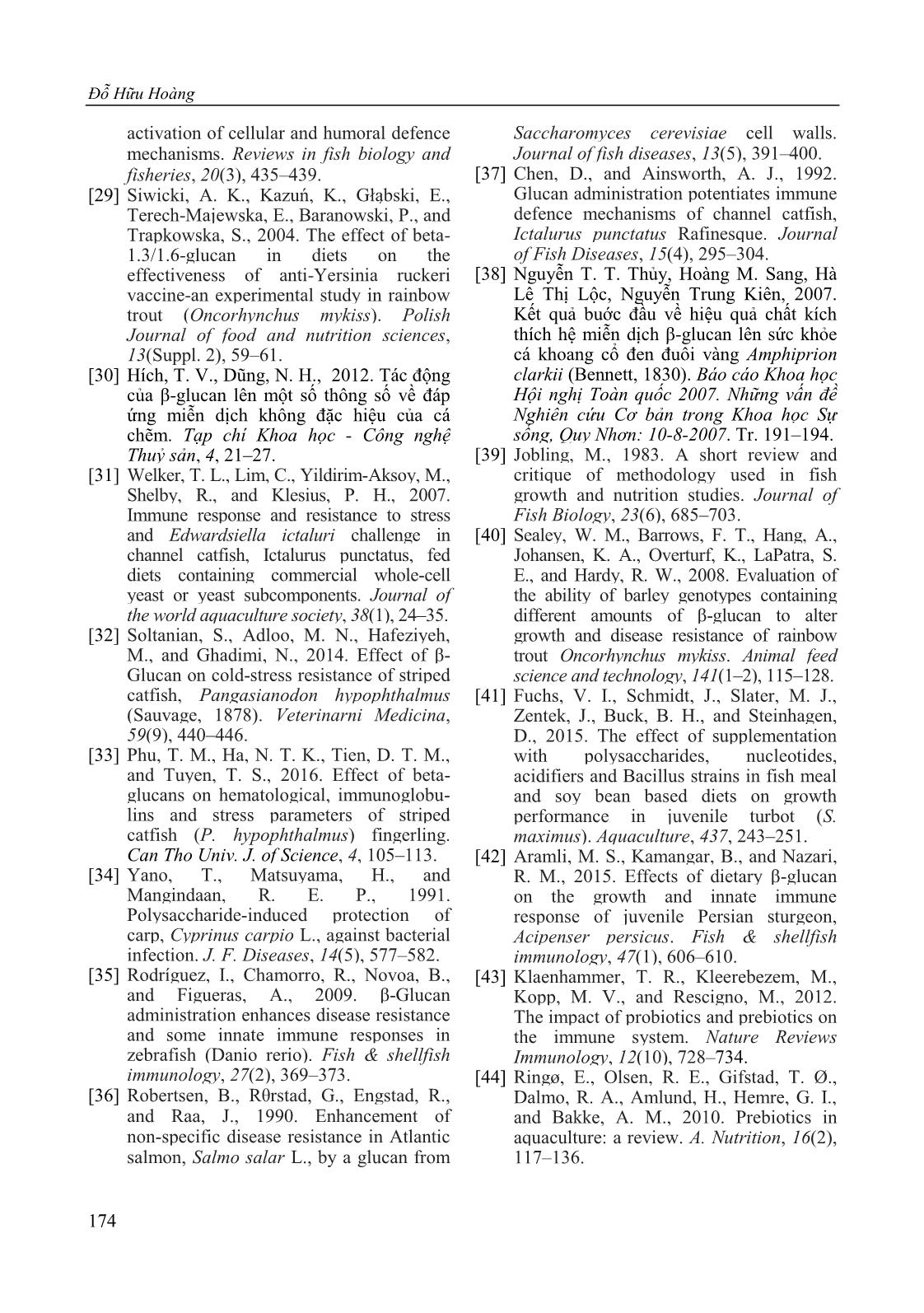
Trang 8
Tóm tắt nội dung tài liệu: Efficiency of β-glucan utilisation in fish culture
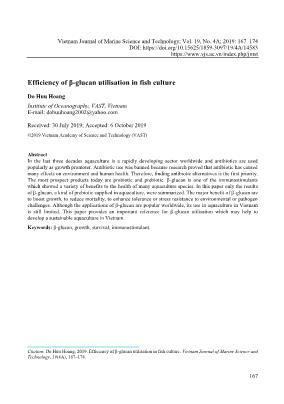
được tắm β-glucan (18,4 mg/l) cũng tăng đáng kể. ẢNH HƯỞNG CỦA β-GLUCAN LÊN THÀNH PHẦN SINH HÓA VẬT NUÔI Thành phần sinh hóa là chỉ thị quan trọng của tình trạng dinh dưỡng và sức khỏe của cá [39]. Việc ảnh hưởng của việc bổ sung prebiotic lên thành phần sinh hóa của cá vẫn chưa được hiểu biết một cách đầy đủ và có thể tùy thuộc vào từng loài, hoặc chịu ảnh hưởng của từng loại prebiotic. Cá white fish, Rutilus frisii kutum cho ăn bổ sung BG làm tăng hàm lượng protein, tuy nhiên hàm lượng lipid, tro và độ ẩm không thay đổi [18]. Ở cá chim vây ngắn, việc bổ sung lượng β-glucan thích hợp và thức ăn đã cho kết quả tăng hàm lượng protein và giảm hàm lượng lipid trong cơ của cá [12]. Ngược lại việc bổ sung β-glucan vào thức ăn không làm ảnh hưởng đến hàm lượng protein và lipid trên cá hồi, Oncorhynchus mykiss [40] hoặc cá bơn, Scophthalmus maximus [41]. Hiệu quả sử dụng thức ăn và dinh dưỡng, thành phần sinh hóa của cá chim vây ngắn cũng nâng cao khi bổ sung một hàm lượng β-glucan thích hợp vào thức ăn của chúng [12]. ẢNH HƯỞNG LÊN THÀNH PHẦN TẾ BÀO MÁU Bổ sung β-glucan cũng làm thay đổi các chỉ số huyết học trên nhiều loài thủy sản khác nhau. Ở cá tầm, Acipenser persicu việc bổ sung BG cho kết quả tăng số lượng bạch cầu và tế bào lympho, tuy nhiên các chỉ số tế bào máu khác không thay đổi [42]. Tương tự, monocyte and neutrophils tăng đáng kể khi cho cá hồng, Lutjanus guttatus ăn bổ sung 0,05% và 0,1% β- glucan [21]. Tương tự, số lượng bạch cầu lympho cầu tăng cao ở cá chim vây ngắn cho ăn bổ sung 0,05–0,2% β-glucan [8]. Tuy nhiên bổ sung BG không làm thay đổi số lượng hồng cầu và chỉ số hồng cầu trên cá nheo channel catfish, Ictalurus punctatus [31]. Bổ sung β- glucan vào thức ăn làm tăng hàm lượng bạch cầu tổng số và một số thông số tế bào máu khác của cá chim vây ngắn, Trachinotus ovatus [8]. ẢNH HƯỞNG LÊN VI SINH TRONG ỐNG TIÊU HÓA Hệ vi khuẩn đường ruột đóng vai trò quan trọng trong quá trình trao đổi chất, hấp thụ dinh dưỡng và hệ miễn dịch cũng như sức khỏe của cá. Nhiều kết quả nghiên cứu cho thấy bổ sung β-glucan cho kết quả cải thiện hệ vi khuẩn đường ruột ở nhiều động vật không xương sống khác [43]. Số lượng Vibrio trong ruột cá chim vây ngắn cũng giảm đáng kể khi bổ sung β- glucan vào thức ăn của loài này trong 8 tuần [8]. Hiệu quả của β-glucan trong việc nâng cao tốc độc sinh trưởng có thể được giải thích thông qua việc β-glucan cung cấp năng lượng cho cá nuôi [13], kích thích sự phát triển của nhóm vi sinh vật có lợi [44]. Đỗ Hữu Hoàng 172 Tóm lại nhiều nghiên cứu đã chứng minh hiệu quả của β-glucan trên nhiều loài cá nuôi, bao gồm: Nâng cao tốc độ sinh trưởng, tăng tỷ lệ sống, cải thiện hệ miễn dịch bao gồm: Tăng số lượng bạch cầu, tăng cường tính thực bào, tăng độc tính kháng khuẩn (cytotoxic), tăng hoạt động kháng khuẩn và khả năng chống chọi với các vi khuẩn gây bệnh. Mặc dù có nhiều công trình chứng minh hiệu quả của β-glucan trên các loài thủy sản khác nhau, việc bổ sung β-glucan có thể không cho kết quả tốt hoặc thậm chí gây hại trên một số loài. Ngoài ra nhiều vấn đề còn bỏ ngỏ như: Hiệu quả bổ sung theo thời gian, liều lượng bổ sung, ảnh hưởng trên các giai đoạn sinh trưởng và sinh lý khác nhau. Ngoài ra tác dụng trên từng loài thủy sản cũng có thể khác nhau. Lời cảm ơn: Nghiên cứu này được tài trợ bởi Quỹ Phát triển khoa học và công nghệ Quốc gia (NAFOSTED) trong đề tài mã số 106.05- 2019.04. Tác giả xin chân thành cảm ơn ban Lãnh đạo Quỹ Nafosted, Viện Hải dương học và những ý kiến đóng góp quý báu của các đồng nghiệp để hoàn chỉnh báo cáo. TÀI LIỆU THAM KHẢO [1] FAO, 2018. The State of World Fisheries and Aquaculture 2018‐Meeting the sustainable development goals. Rome. Licence: CC BY-NC-SA 3.0 IG. [2] Scholz, U., Diaz, G. G., Ricque, D., Suarez, L. C., Albores, F. V., and Latchford, J., 1999. Enhancement of vibriosis resistance in juvenile Penaeus vannamei by supplementation of diets with different yeast products. Aquaculture, 176(3–4), 271–283. [3] Gatlin, D. M., 2002. Nutrition and Fish Health. In: Halver, J., Hardy, R., editors. Fish Nutrition, Third Edition. San Diego, California, USA: Academic Press. pp. 671– 702. [4] Rawles, S. D., Kocabas, A., Gatlin III, D. M., Du, W. X., and Wei, C. I., 1997. Dietary Supplementation of Terramycin and Romet‐30 Does Not Enhance Growth of Channel Catfish But Does Influence Tissue Residues. Journal of the World Aquaculture Society, 28(4), 392–401. [5] Food and Agriculture Organization of United Nations, 2002. Antibiotics residue in aquaculture products. The State of World Fisheries and Aquaculture 2002, 74–82. [6] Do Huu, H., and Jones, C. M. (2014). Effects of dietary mannan oligosaccharide supplementation on juvenile spiny lobster Panulirus homarus (Palinuridae). Aquaculture, 432, 258–264. [7] Do-Huu, H., & Nguyen, T. K. (2017). Influence of dietary mannan oligosaccharides supplementation on fingerling clownfish, Amphiprion ocellaris (Cuvier, 1830). Journal of Coastal Life Medicine, 5(8), 325–329. [8] Do Huu, H., Sang, H. M., and Thuy, N. T. T., 2016. Dietary β-glucan improved growth performance, Vibrio counts, haematological parameters and stress resistance of pompano fish, Trachinotus ovatus Linnaeus, 1758. Fish & shellfish immunology, 54, 402–410. [9] Do Huu, H., Tabrett, S., Hoffmann, K., Köppel, P., and Barnes, A. C., 2013. The purine nucleotides guanine, adenine and inosine are a dietary requirement for optimal growth of black tiger prawn, P. monodon. Aquaculture, 408, 100–105. [10] Raa, J., Roestad, G., Engstad, R. E., and Robertsen, B., 1992. The use of immunostimulants to increase resistance of aquatic organism to microbial infections. In: Shariff, I. M., Subasinghe, R. P., Arthur J. R., (eds) Diseases in Asian aquaculture. Health Fish Section, Asian Fisheries Society, Manila, pp. 39–50. [11] Robertsen, B., 1999. Modulation of the non-specific defence of fish by structurally conserved microbial polymers. Fish & Shellfish Immunology, 9(4), 269–290. [12] Hoang, D. H., Lam, H. S., and Nguyen, C. V., 2018. Efficiency of Dietary β-glucan Supplementation on Growth, Body Composition, Feed, and Nutrient Utilization in Juveniles of Pompano Fish (T. ovatus, Linnaeus, 1758). The Israeli Journal of Aquaculture - Bamidgeh, 13. [13] Ai, Q., Mai, K., Zhang, L., Tan, B., Zhang, W., Xu, W., and Li, H., 2007. Effects of dietary β-1, 3 glucan on innate Hiệu quả của việc sử dụng β-glucan trong nuôi cá 173 immune response of large yellow croaker, Pseudosciaena crocea. Fish & Shellfish Immunology, 22(4), 394–402. [14] Munir, M. B., Hashim, R., Manaf, M. S. A., and Nor, S. A. M., 2016. Dietary prebiotics and probiotics influence the growth performance, feed utilisation, and body indices of snakehead (Channa striata) fingerlings. Tropical Life Sciences Research, 27(2), 111–125. [15] Refstie, S., Baeverfjord, G., Seim, R. R., and Elvebø, O., 2010. Effects of dietary yeast cell wall β-glucans and MOS on performance, gut health, and salmon lice resistance in Atlantic salmon (Salmo salar) fed sunflower and soybean meal. Aquaculture, 305(1–4), 109–116. [16] Lin, S., Pan, Y., Luo, L., and Luo, L., 2011. Effects of dietary β-1, 3-glucan, chitosan or raffinose on the growth, innate immunity and resistance of koi (Cyprinus carpio koi). Fish & shellfish immunology, 31(6), 788–794. [17] Misra, C. K., Das, B. K., Mukherjee, S. C., and Pattnaik, P., 2006. Effect of long term administration of dietary β-glucan on immunity, growth and survival of Labeo rohita fingerlings. Aquaculture, 255(1–4), 82–94. [18] Rufchaie, R., and Hoseinifar, S. H., 2014. Effects of dietary commercial yeast glucan on innate immune response, hematological parameters, intestinal microbiota and growth performance of white fish (Rutilus frisii kutum) fry. Croatian Journal of Fisheries, 72(4), 156–163. [19] Whittington, R., Lim, C., and Klesius, P. H., 2005. Effect of dietary β-glucan levels on the growth response and efficacy of Streptococcus iniae vaccine in Nile tilapia, Oreochromis niloticus. Aquaculture, 248(1–4), 217–225. [20] Li, P., Wen, Q., and Gatlin III, D. M., 2009. Dose‐dependent influences of dietary β‐1, 3‐glucan on innate immunity and disease resistance of hybrid striped bass Morone chrysops× Morone saxatilis. Aquaculture research, 40(14), 1578–1584. [21] Del Rio‐Zaragoza, O. B., Fajer‐Ávila, E. J., and Almazán‐Rueda, P., 2011. Influence of β‐glucan on innate immunity and resistance of Lutjanus guttatus to an experimental infection of dactylogyrid monogeneans. Parasite Immunology, 33(9), 483–494. [22] Jeney, G., Galeotti, M., Volpatti, D., Jeney, Z., and Anderson, D. P., 1997. Prevention of stress in rainbow trout (Oncorhynchus mykiss) fed diets containing different doses of glucan. Aquaculture, 154(1), 1–15. [23] Thuy, N. T. T., Thoa, N. T., Dung, N. H., Wergeland, I. H., 2012. Effect of oral administration of ß-glucan as an immune- stimulant on phagocytic activity and antibacterial of orange - spotted grouper Epinephelus coioides. Journal of Agri- culture and Rural Development, 62–67. [24] Gantner, B. N., Simmons, R. M., Canavera, S. J., Akira, S., and Underhill, D. M., 2003. Collaborative induction of inflammatory responses by dectin-1 and Toll-like receptor 2. Journal of Experimental medicine, 197(9), 1107–1117. [25] Raa, J., 2000. The use of immune- stimulants in fish and shellfish feeds. In: Cruz -Suárez, L. E., Ricque-Marie, D., Tapia-Salazar, M., Olvera-Novoa, M. A., Civera-Cerecedo, R., (Eds). Avances en Nutrición Acuícola V Memorias del V Simposium Internacional de Nutrición Acuícola, 19-22/11/2000 Mérida, Yucatán, Mexico. pp. 47–56. [26] Paulsen, S. M., Lunde, H., Engstad, R. E., and Robertsen, B., 2003. In vivo effects of β-glucan and LPS on regulation of lysozyme activity and mRNA expression in Atlantic salmon (Salmo salar L.). Fish & Shellfish Immunology, 14(1), 39–54. [27] Selvaraj, V., Sampath, K., and Sekar, V., 2005. Administration of yeast glucan enhances survival and some non-specific and specific immune parameters in carp (Cyprinus carpio) infected with Aeromonas hydrophila. Fish & shellfish immunology, 19(4), 293–306. [28] Siwicki, A. K., Zakęś, Z., Terech- Majewska, E., Kazuń, K., Lepa, A., and Głąbski, E., 2010. Dietary Macrogard reduces Aeromonas hydrophila mortality in tench (Tinca tinca) through the Đỗ Hữu Hoàng 174 activation of cellular and humoral defence mechanisms. Reviews in fish biology and fisheries, 20(3), 435–439. [29] Siwicki, A. K., Kazuń, K., Głąbski, E., Terech-Majewska, E., Baranowski, P., and Trapkowska, S., 2004. The effect of beta- 1.3/1.6-glucan in diets on the effectiveness of anti-Yersinia ruckeri vaccine-an experimental study in rainbow trout (Oncorhynchus mykiss). Polish Journal of food and nutrition sciences, 13(Suppl. 2), 59–61. [30] Hích, T. V., Dũng, N. H., 2012. Tác động của β-glucan lên một số thông số về đáp ứng miễn dịch không đặc hiệu của cá chẽm. Tạp chí Khoa học - Công nghệ Thuỷ sản, 4, 21–27. [31] Welker, T. L., Lim, C., Yildirim‐Aksoy, M., Shelby, R., and Klesius, P. H., 2007. Immune response and resistance to stress and Edwardsiella ictaluri challenge in channel catfish, Ictalurus punctatus, fed diets containing commercial whole‐cell yeast or yeast subcomponents. Journal of the world aquaculture society, 38(1), 24–35. [32] Soltanian, S., Adloo, M. N., Hafeziyeh, M., and Ghadimi, N., 2014. Effect of β- Glucan on cold-stress resistance of striped catfish, Pangasianodon hypophthalmus (Sauvage, 1878). Veterinarni Medicina, 59(9), 440–446. [33] Phu, T. M., Ha, N. T. K., Tien, D. T. M., and Tuyen, T. S., 2016. Effect of beta- glucans on hematological, immunoglobu- lins and stress parameters of striped catfish (P. hypophthalmus) fingerling. Can Tho Univ. J. of Science, 4, 105–113. [34] Yano, T., Matsuyama, H., and Mangindaan, R. E. P., 1991. Polysaccharide‐induced protection of carp, Cyprinus carpio L., against bacterial infection. J. F. Diseases, 14(5), 577–582. [35] Rodríguez, I., Chamorro, R., Novoa, B., and Figueras, A., 2009. β-Glucan administration enhances disease resistance and some innate immune responses in zebrafish (Danio rerio). Fish & shellfish immunology, 27(2), 369–373. [36] Robertsen, B., Rθrstad, G., Engstad, R., and Raa, J., 1990. Enhancement of non‐specific disease resistance in Atlantic salmon, Salmo salar L., by a glucan from Saccharomyces cerevisiae cell walls. Journal of fish diseases, 13(5), 391–400. [37] Chen, D., and Ainsworth, A. J., 1992. Glucan administration potentiates immune defence mechanisms of channel catfish, Ictalurus punctatus Rafinesque. Journal of Fish Diseases, 15(4), 295–304. [38] Nguyễn T. T. Thủy, Hoàng M. Sang, Hà Lê Thị Lộc, Nguyễn Trung Kiên, 2007. Kết quả buớc đầu về hiệu quả chất kích thích hệ miễn dịch β-glucan lên sức khỏe cá khoang cổ đen đuôi vàng Amphiprion clarkii (Bennett, 1830). Báo cáo Khoa học Hội nghị Toàn quốc 2007. Những vấn đề Nghiên cứu Cơ bản trong Khoa học Sự sống, Quy Nhơn: 10-8-2007. Tr. 191–194. [39] Jobling, M., 1983. A short review and critique of methodology used in fish growth and nutrition studies. Journal of Fish Biology, 23(6), 685–703. [40] Sealey, W. M., Barrows, F. T., Hang, A., Johansen, K. A., Overturf, K., LaPatra, S. E., and Hardy, R. W., 2008. Evaluation of the ability of barley genotypes containing different amounts of β-glucan to alter growth and disease resistance of rainbow trout Oncorhynchus mykiss. Animal feed science and technology, 141(1–2), 115–128. [41] Fuchs, V. I., Schmidt, J., Slater, M. J., Zentek, J., Buck, B. H., and Steinhagen, D., 2015. The effect of supplementation with polysaccharides, nucleotides, acidifiers and Bacillus strains in fish meal and soy bean based diets on growth performance in juvenile turbot (S. maximus). Aquaculture, 437, 243–251. [42] Aramli, M. S., Kamangar, B., and Nazari, R. M., 2015. Effects of dietary β-glucan on the growth and innate immune response of juvenile Persian sturgeon, Acipenser persicus. Fish & shellfish immunology, 47(1), 606–610. [43] Klaenhammer, T. R., Kleerebezem, M., Kopp, M. V., and Rescigno, M., 2012. The impact of probiotics and prebiotics on the immune system. Nature Reviews Immunology, 12(10), 728–734. [44] Ringø, E., Olsen, R. E., Gifstad, T. Ø., Dalmo, R. A., Amlund, H., Hemre, G. I., and Bakke, A. M., 2010. Prebiotics in aquaculture: a review. A. Nutrition, 16(2), 117–136.
File đính kèm:
 efficiency_of_glucan_utilisation_in_fish_culture.pdf
efficiency_of_glucan_utilisation_in_fish_culture.pdf

